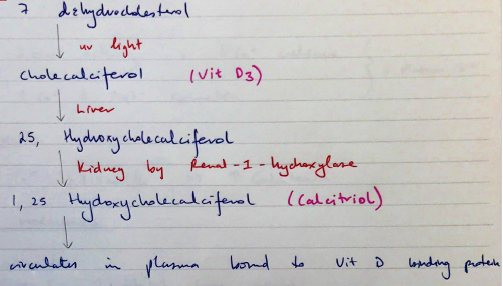U1vii / 17A05 / 16B01: Describe the control of plasma calcium
17A05: Exam Report
Describe the regulation of plasma calcium concentration.
51% of candidates passed this question.
High scoring answers discussed the three major hormones involved in calcium regulation – parathyroid hormone, vitamin D and calcitonin. For each of these it was expected that candidates include: site of production, stimulus for release, inhibitory factors and actions. In the case of renin it was expected that candidates also include the actions of angiotensin and aldosterone. Very few answers discussed inhibitory factors or negative feedback loops.
16B01: Exam Report
Outline the distribution of calcium in normal plasma (20% of marks). Describe the hormonal control of the calcium concentration in the plasma (80% of marks).
53% of candidates passed this question.
As stated in the question, the distribution in plasma (not body) was expected. Candidates are reminded to include units [mmol/l]. Many candidates spent considerable effort describing the roles of calcium and particularly its role in excitation contraction coupling – which was not asked and hence scored no marks.
It was expected that candidates were able to identify the roles of parathormone (PTH), 1,25 OH vitamin D and calcitonin as the major hormonal regulators. Better answers were able to describe the physiology and integration of these hormones at the gut, kidney and bone. Calcitonin and its transient and (probable) minor opposite role were also identified in these answers.
Better answers were also able to identify the permissive roles of growth hormone, cortisol and thyroxine.
U1vii / 17A05 / 16B01: Outline the distribution of calcium in normal plasma - Discuss the regulation of plasma calcium - Compare & Contrast Calcium Gluconate and Chloride
Definition
Ca2+ = a divalent cation
Distribution
- 99% → bone → not readily exchangeable
- 10% → PLASMA → readily exchangeable
- 45% free Ca2+
- 45% Ca2+ bound with Albumin
- 10% calcium complexes (citrate, carbonate, hydrogen phosphate)
Plasma Ca2+ Ref Range = 2.20 – 2.55 mmol/L
ICF Ca2+ is v. low = 100nM
Function
- Membrane excitation → nerves + muscles
- Haemostasis → activation of clotting factors
- Muscle contraction → excitation – contraction coupling
- Excitation – secretion processes → release NTs, hormones
- Structural support → bone, membrane stabilisation + cell adhesion
Calcium Metabolism
Regulated by 3 hormones
- PTH
- 1,25 hydroxycholecalciferol (1,25 Vit D3)
- Calcitonin
Regulated by several organs
- Parathyroid gland (PTH)
- Thyroid gland (calcitonin)
- Bone (Ca/PO4 reservoir)
- Skin (Vit D activation)
- Liver (Vit D metabolism)
- GI (Ca2+ absorption)
- Kidney (Vit D metabolism)
PTH = ↑ plasma Ca2+
- Polypeptide hormone
- Released by Chief cells of Parathyroid Gland
Effects
- Bone – ↑ clast activity → ↑free Ca2+
- Kidney – ↑Ca2+ at distal tubule
- ↓PO4 at proximal tubule
- ↑1α-hydroxylase activity (active Vit D3 production)
- Gut – ↑Ca2+ (indirect via Calcitriol)
Regulation
- Ionised Ca2+
- ↓Ca2+ → β-adr stimulation → ↑PTH release
- ↑Ca2+ → Gq → ↓PTH release
- Calcitriol – ↓PTH synthesis
- Requires Mg2+ for secretion
Vitamin D = ↑ Plasma Ca2+, ↑ Bone Formation
- Steroid compound made from cholesterol
Synthesis

Effects
- GUT – ↑Ca2+ reabsorption
- Kidney – ↑Ca2+ reabsorption
- Bone – ↑blast activity → formation & calcification of bone
- PTH Gland – ↓PTH synthesis (neg feedback)
Regulation
- PTH → ↑ Renal-1-hydroxylase
- ↑PO42- → ↓ Renal-1-hydroxylase
Calcitonin = ↓ Plasma Ca2+
- Polypeptide hormone
- Secreted by PARAFOLLICULAR CELLS of thyroid gland
Effects
- Bone – ↓blast activity = ↓ Ca2+ release
- Kidney – ↑Ca2+ & PO42- excretion
Regulation
- Plasma Ca2+ > 2.4mmol/L → ↑Calcitonin
Other Hormones
Glucocorticoids
- Short T → inhibit bone reabsorption
- Long T → ↓turnover ∴osteoporosis
- Inhibit Ca2+ absorption gut
Growth Hormone
- ↑Ca2+ excretion urine
- ↑Ca2+ absorption gut
- Overall +ve Ca2+ balance
Thyroid Hormone
- Hypercalcaemia
- Hypercalciuria
- Osteoporosis
Oestrogen
- Inhibits bone resorption
- Author: Krisoula Zahariou